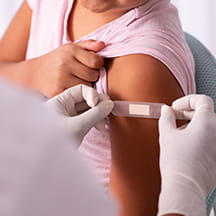After Naomi* broke free from an abusive relationship, she found herself in desperate circumstances with two children under the age of three. Legal fees for the divorce consumed her savings. Her kitchen pantry stood empty. Bureaucratic and technical roadblocks stalled her applications for food stamps and health insurance.
When she reached a breaking point, someone referred her to an organization that could help. Over the next year, she received guidance through each of her challenges — enrolling in public benefits programs, stocking her kitchen with nutritious foods, finding stable housing, and receiving small necessities along the way.
“Today, I’ve successfully and safely relocated with my children, and we no longer need assistance for food or housing,” she said.
Naomi’s help came from an unexpected source. It was not a shelter, or a ministry, or a society. It was not a government agency.
It was a children’s hospital — Wolfson Children’s Hospital in Jacksonville, Florida, home of The PLAYERS Center for Child Health, which focuses on the health, wellness, and quality of life of the families living within its community.
“My first meeting with the Wolfson Children’s team marked a significant turning point in my life,” Naomi said.
Naomi is one of thousands of people to benefit from the variety of services provided through The PLAYERS Center. The hospital helps people apply for Medicaid and the Supplemental Nutrition Assistance Program (SNAP). A team of navigators connects those in need with food supplies, legal services, childcare, public transit passes, employment support, rent and utility assistance, clothing, and diapers. Clinical staff also serve the greater community, providing asthma training, health education, school-based health services, injury prevention programs, infant safety programs, and more.
“Providing community benefits outside the hospital walls is essential to our mission,” said Allegra Jaros, president of Wolfson Children’s Hospital. “We know that health outcomes depend on a number of factors outside health care, such as poverty, housing, food security, transportation, and access to education. We established a program at the center to help connect families with the community resources they need when they need them most.”
One mother who had been without a home for two years received a permanent housing voucher through the center, along with temporary shelter, transportation, and clothes until a permanent residence became available. A foster grandmother couldn’t get a prescription for her grandson’s inhaler until a navigator secured the proper legal paperwork through a medical-legal partnership.
“We have story after story like this about people in our community finding stability and overcoming barriers. So many of them say they had no idea the hospital offered services like these,” said Megan Denk, executive director of The PLAYERS Center.
Benefits beyond the hospital walls
Children’s hospitals in the U.S. routinely invest in the communities they serve, including far-reaching rural areas. The benefits and services they provide address factors that contribute to poor health outcomes. Evidence shows those factors, called social determinants of health (SDOH), involve nearly every aspect of a child’s environment and drive up to 80% of health outcomes
Children’s hospitals predominantly serve patients covered by Medicaid, which reimburses hospitals at lower rates than private insurance, sometimes below the cost of care. They also regularly provide care to children with no health insurance. Costs of uncompensated care and Medicaid underpayments can add up to tens of millions of dollars per year for a single hospital.
Even so, children’s hospitals invest operational dollars, along with funds from grants and philanthropic support, into community programs like housing remediation, financial mentorship, environmental services, food clinics, legal services, and more. According to an American Hospital Association (AHA) analysis, tax-exempt hospitals provided more than $129 billion in total benefit to their communities in 2020 alone.
Community programs are varied among children’s hospitals. In Washington, D.C., Children’s National Hospital works with local school districts to reduce chronic absenteeism. Connecticut Children’s fixes homes to remedy hazardous conditions. Nationwide Children’s Hospital in Ohio helps children in under-resourced communities prepare for kindergarten. The Cleveland Clinic strengthens local businesses through free mentorship programs in supply chain management.
“The depth and breadth of community benefit children’s hospitals and health systems offer is astounding,” said Matthew Cook, CEO of Children’s Hospital Association. “They do so much more than clinical care and really serve as anchors in their communities.”
Children’s hospitals also provide financial assistance, debt relief, and caregiver training to families within the hospital. At the same time, they use funds to train pediatric medical professionals, which require specialized education, and conduct essential research, advancing treatments in crucial areas like cancer and pediatric-specific diseases.
“Education and research are the foundation of pediatric health care. Caring for children often requires special tools, treatments, or training. These investments enable the highest quality of care for children in the U.S.,” Cook said. “Today we’re seeing remarkable treatments like gene therapy curing life-altering diseases that were previously untreatable.”
For community, by community
The PLAYERS Center at Wolfson Children’s Hospital started with an asthma program, but it began helping people applying for Medicaid and CHIP after a local organization asked the hospital to help build capacity in the application process. Then came upstream behavioral health programs, resources to address social determinants of health, and community initiatives to reduce infant mortality — all developed in response to community needs.
“The PLAYERS Center is truly community driven,” Denk said. “All of our programs are tailored to needs identified by the community, and it has evolved over the years to address the needs as they have changed.”
Every three years, children’s hospitals conduct a thorough assessment to understand their community’s specific health needs, as required by the Affordable Care Act. From that, they design programs and then measure and report on their impact annually. Throughout the process, hospitals engage community members and stakeholders, which inform not only the assessment but also the solutions. The hospitals often co-design programs with community organizations or partner with those who have trusted relationships with the community.
“A lot of our work is in collaboration with other community resources. Rather than duplicating services, we provide navigation,” Denk said. “Whatever door they come through to get to us, we can try to point them through all the other doors that they may not be aware of.”
For community members like Naomi, having a local children’s hospital as an accessible community resource can make all the difference. “The Wolfson Children’s navigator’s compassion and care, during a time when I was burdened with shame and anxiety of not being able to feed my babies, left a lasting impact,” she said. “I’m so grateful for their kindness and invaluable support during my darkest days.”
*Name changed for anonymity


